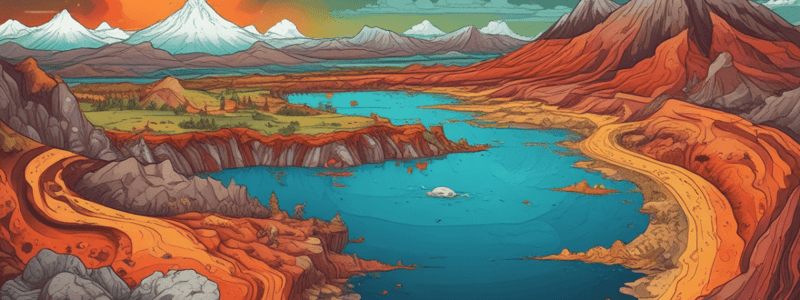Podcast
Questions and Answers
What happens to rocks formed from ocean floor weathering?
What happens to rocks formed from ocean floor weathering?
- They get dissolved in the ocean
- They are buried under sediment
- They turn into magma (correct)
- They break into smaller pieces
What is trapped below the Earth's surface during the weathering process?
What is trapped below the Earth's surface during the weathering process?
- Nitrogen
- Oxygen
- Water
- Carbon dioxide (correct)
Where is carbon dioxide released from the Earth's interior?
Where is carbon dioxide released from the Earth's interior?
- Hot springs
- Volcanic vents (correct)
- Weathering rocks
- Earthquakes
What forms an equilibrium with atmospheric carbon dioxide?
What forms an equilibrium with atmospheric carbon dioxide?
What is the process called that involves the recycling of carbon dioxide through weathering, magma formation, and volcanic eruptions?
What is the process called that involves the recycling of carbon dioxide through weathering, magma formation, and volcanic eruptions?
Rocks formed from the weathering process on the ocean floor eventually end up as sedimentary rocks.
Rocks formed from the weathering process on the ocean floor eventually end up as sedimentary rocks.
Carbon dioxide is released into the atmosphere through volcanic eruptions.
Carbon dioxide is released into the atmosphere through volcanic eruptions.
The Earth's tectonic plates are involved in the formation of magma from weathered rocks.
The Earth's tectonic plates are involved in the formation of magma from weathered rocks.
The dissolved carbon dioxide in the ocean forms an equilibrium with the carbon dioxide in the Earth's crust.
The dissolved carbon dioxide in the ocean forms an equilibrium with the carbon dioxide in the Earth's crust.
Molten lava from volcanic eruptions cools and forms new rocks, starting the weathering process again.
Molten lava from volcanic eruptions cools and forms new rocks, starting the weathering process again.
Rocks that have formed from the weathering process on the bottom of the ocean floor eventually end up as ______ with the movements of the Earth's tectonic plates.
Rocks that have formed from the weathering process on the bottom of the ocean floor eventually end up as ______ with the movements of the Earth's tectonic plates.
This process traps ______ below the Earth's surface.
This process traps ______ below the Earth's surface.
More ______ is released when volcanoes erupt.
More ______ is released when volcanoes erupt.
Molten lava is also released from the volcano, forming new rocks and the weathering process starts all over again, this is called the ______ carbon cycle.
Molten lava is also released from the volcano, forming new rocks and the weathering process starts all over again, this is called the ______ carbon cycle.
The dissolved ______ dioxide in the ocean forms an equilibrium with atmospheric carbon dioxide.
The dissolved ______ dioxide in the ocean forms an equilibrium with atmospheric carbon dioxide.
What is the primary mechanism by which carbon dioxide is trapped beneath the Earth's surface?
What is the primary mechanism by which carbon dioxide is trapped beneath the Earth's surface?
What is the primary role of the Earth's tectonic plates in the carbon cycle?
What is the primary role of the Earth's tectonic plates in the carbon cycle?
What is the ultimate fate of the rocks that form from the weathering process on the ocean floor?
What is the ultimate fate of the rocks that form from the weathering process on the ocean floor?
What is the purpose of the equilibrium between dissolved carbon dioxide in the ocean and atmospheric carbon dioxide?
What is the purpose of the equilibrium between dissolved carbon dioxide in the ocean and atmospheric carbon dioxide?
What is the net result of the long carbon cycle?
What is the net result of the long carbon cycle?
Flashcards are hidden until you start studying
Study Notes
The Long Carbon Cycle
- Weathered rocks from the ocean floor eventually transform into magma due to Earth's tectonic plate movements.
- This process traps carbon dioxide beneath the Earth's surface.
- Some trapped carbon dioxide is released into the ocean through vents and reaches equilibrium with atmospheric carbon dioxide.
- Volcanic eruptions release more carbon dioxide into the atmosphere.
- Volcanic eruptions also release molten lava, which forms new rocks, restarting the weathering process.
- This continuous process is known as the long carbon cycle.
The Long Carbon Cycle
- Weathered rocks from the ocean floor eventually transform into magma due to Earth's tectonic plate movements.
- This process traps carbon dioxide beneath the Earth's surface.
- Some trapped carbon dioxide is released into the ocean through vents and reaches equilibrium with atmospheric carbon dioxide.
- Volcanic eruptions release more carbon dioxide into the atmosphere.
- Volcanic eruptions also release molten lava, which forms new rocks, restarting the weathering process.
- This continuous process is known as the long carbon cycle.
The Long Carbon Cycle
- Weathered rocks from the ocean floor eventually transform into magma due to Earth's tectonic plate movements.
- This process traps carbon dioxide beneath the Earth's surface.
- Some trapped carbon dioxide is released into the ocean through vents and reaches equilibrium with atmospheric carbon dioxide.
- Volcanic eruptions release more carbon dioxide into the atmosphere.
- Volcanic eruptions also release molten lava, which forms new rocks, restarting the weathering process.
- This continuous process is known as the long carbon cycle.
The Long Carbon Cycle
- Weathered rocks from the ocean floor eventually transform into magma due to Earth's tectonic plate movements.
- This process traps carbon dioxide beneath the Earth's surface.
- Some trapped carbon dioxide is released into the ocean through vents and reaches equilibrium with atmospheric carbon dioxide.
- Volcanic eruptions release more carbon dioxide into the atmosphere.
- Volcanic eruptions also release molten lava, which forms new rocks, restarting the weathering process.
- This continuous process is known as the long carbon cycle.
Studying That Suits You
Use AI to generate personalized quizzes and flashcards to suit your learning preferences.




